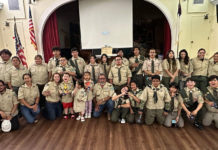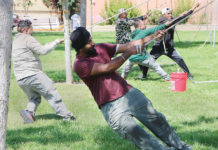
On Jan. 8, as the third deluge in a little more than a week bore down upon the Central Coast, Pajaro Valley Unified School District closed all of its schools, a measure they said was intended to protect kids and their families from possible flooding.
In Mid-County, school officials closed Soquel and Main Street elementary schools.
The moves were one of many preventative measures officials across Santa Cruz and Monterey counties took to protect citizens from floodwaters as rivers and streams neared or exceeded their flood stages.
This included the mandatory evacuation of 4,600 residences in Watsonville, and flash flood warnings and the specter of evacuation for many others. In Pajaro, about 300 households were evacuated for roughly 1,000 people.
PVUSD kept many schools closed through Thursday.
Gov. Gavin Newsom paid a visit to Capitola Village on Tuesday, an area that was severely damaged when a tidal surge drove logs and debris into several seaside restaurants and inundated many other businesses with water.
Santa Cruz County spokesman Jason Hoppin says that 32,000 people countywide were under evacuation orders on Jan. 9, although authorities were only enforcing those orders in low-lying communities where floodwaters gather.
Parts of the San Lorenzo River flooded on Jan. 9, including in Felton Grove and Big Trees, where rescue crews used a Jet Ski to aid in their efforts.
Officials again closed Highway 1 at the River Street bridge to allow for debris removal.
Leslie Garcia, who lives in the Bay Village neighborhood in Watsonville, said the floodwaters reached more than a foot just outside the door of her Hushbeck Street residence.
“I’ve never seen these kinds of conditions in this neighborhood,” she said. “At one point someone showed up with a canoe. This has been very trying.”
Andy Gonzalez, who lives on Atri Court in Bay Village, said his home was flooded with four inches of water on New Year’s Eve.
“We lost the first round but we were ready this second time,” he said, referring to the second wave of flood waters that rose up Monday morning and again filled scores of streets in Bay and Pajaro villages as well as Pajaro Vista. Water also blanketed Bridge Street and adjoining streets for several hours, before settling back down.
“A crew from Public Works came in and set up two pumps here on Atri and then opened up two manhole covers. That just drained everything away in minutes, “ Gonzalez said. “It was amazing to watch.”
A daylong storm on Jan. 11 did not wreak the havoc of its predecessors. The Pajaro River Levee held, even as the water level crept close to the 32-foot flood stage and crews overnight shored up leaking sections.
In a presentation Tuesday to the Santa Cruz County Board of Supervisors, Dave Reid, who runs Santa Cruz County’s Office of Response, Recovery & Resilience, called the storm damage so far “unprecedented,” with rains that flooded the San Lorenzo River, as well as Soquel Creek for the first time in more than 40 years.
Some 45 roads were closed during the storms, including Redwood Road that collapsed and trapped residents, said Public Works Director Matt Machado.
Crews have been working nonstop since New Year’s Eve to clear fallen trees, in addition to maintaining drainages, sanitation systems and maintaining the County’s infrastructure, Machado says. This includes 11 emergency contractors and crews conducting levee inspections 24 hours a day.
Building inspectors have so far issued 132 yellow tags at damaged homes, meaning they have limited use but residents can still stay. They have also issued eight red tags, meaning the structures are uninhabitable. Both of these numbers are expected to increase.
Machado says that the County will have to choose which projects get done first.
“The magnitude of them is such that we won’t be able to fix them all at once, and so similar to 2017 storms we have to prioritize and do the worst first for various reasons,” he said.
Even as many reservoirs fill and the ground in many places remains saturated—and as more storms make their way to the Central Coast—state water officials say that the ongoing drought is far from over.
The state since 2019 has endured the driest three-year period on record going back to 1896, says California Department of Water Resources spokeswoman Akiela Moses.
This has created a water deficit that will take time—and much more rain and snow—to erase, Moses says.
The wet start to the year has created a good start, but the wet season is only half over, she adds.
Major reservoir storage remains below average, Moses says, and conditions could turn dry, offsetting recent rain and snow.
Groundwater levels in much of the state have also been depleted by the numerous dry years in the last two decades, and it would take more than a single wet year for groundwater levels to substantially improve at the statewide scale, Moses says.












The city of Watsonville erred in allowing homes to be built right next to river. Totally nuts.
we are learning , the hard way, that global climate change is REAL, and that we must rid ourselves of technology that creates CO2 gas. we have no choice if we want to live on this planet. those who post below can go find planet B. they will not be missed.
Climate change? 🤣🤡🌎
How many times has the earth’s climate changed since it came into existance? I’ve experienced changes in the weather many times during the decades I’ve lived. I don’t think I’ve ever noticed the climate change. I have noticed that the smog situation in Southern California has certainly improved since the 1960’s. Did that have something to do with a change in the weather or climate? I’ve also noticed that it can really get hot in Death Valley. What needs to change to cool things off? And some Winters it doesn’t snow much in the Sierra. What causes that? Weather or climate?